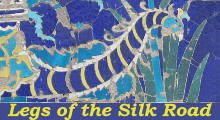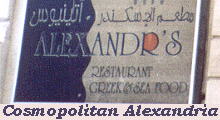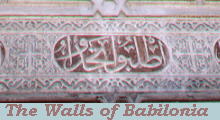

What's New!
Detailed Sitemap
All images © by Roberto Piperno, owner of the domain. Write to romapip@quipo.it. Text edited by Rosamie Moore.
|
 - Bukhara - page two - the Medreses - Bukhara - page two - the Medreses
(detail of a decoration at Abdoul Aziz Khan Medrese in Bukhara)
Similar to Samarkand, the most imposing buildings of Bukhara are medreses,
educational institutions which were not limited to theological schools.
Ouloug Beg Medrese (XVth century)
Ouloug Beg, grandson of Timur, built in 1417-21 the first large medrese of Bukhara. Its design is similar to that which he built in the Registan of Samarkand, although the size of its portal is smaller.
At the time Ouloug Beg was not the ruler of the country, but the governor of the region as his father Shah Roukh preferred to live in Herat (in today's Afghanistan).
Ouloug Beg Medrese: interior
Ouloug Beg was fond of astronomy and also in this medrese he wanted stars to be part of the decoration.
Sometimes by looking too far in the distance the observer does not notice what is right under his nose; this happened to
Ouloug Beg who was assassinated by his own son Abd-ul Latif in 1549.
Abdoul Aziz Khan Medrese (XVIIth century): (left) side view; (centre) mosaic representing a "vase of happiness"; (right) detail of the central niche
Similar to that in Samarkand, also the Ouloug Beg Medrese in Bukhara had the destiny of being faced by another medrese. This was built in 1652 by Abdoul Aziz Khan.
Some mosaics show a Chinese influence: the icon at the top of the page shows a detail of a mosaic and the image used as background for this page does the same. The decoration of the medrese was left unfinished because Abdoul Aziz Khan lost the throne that same year.
Kalon Mosque - main portal (XVIth century)
Kalon means great and this mosque was known also as Jamia (Friday) because all male inhabitants of the city were expected to
attend the Friday prayer in this mosque. When Genghis Khan conquered Bukhara and went inside the mosque he thought he was entering
the (local) royal palace. When he learnt it was a religious building, he first turned it into a stable and then set fire to it.
The current mosque was built in 1514: the portal leading to its courtyard had the objective of showing the wealth and power of the Shaybanid dynasty.
Kalon Mosque (eastern portal of the courtyard) and Kalon Minaret (XIIth century)
In order to allow all the male adults to attend the Friday prayer the courtyard was very large.
Genghis Khan was impressed by the tall minaret which flanked the mosque and spared it.
It was built in 1127 and it served also as a watchtower.
During the Manghit dynasty (1785-1920) it was used as a mean for executing some types of criminals. They had no chance to survive from such a fall.
(left) Alim Khan Medrese (XXth century) and Kalon Minaret; (right) Kalon Mosque: dome
Mohammed Alim Khan, the last emir of Bukhara, built a small medrese next to the minaret;
luckily the modern building was in line with traditional architecture. Notwithstanding being under a Russian protectorate, the Emirs of Bukhara had ample latitude in running the internal
affairs of their country. Mohammed Alim Khan received part of his education in St. Petersburg, but once back in Bukhara he favoured traditionalism and fostered anti-Russian feelings. During the war with the Soviets he murdered hundreds of Russian inhabitants of Bukhara.
Kalon Mosque and details of its decoration
In the small octagonal building in front of the mosque a second imam repeated to the crowd in the courtyard the prayers and sermons which were said by the principal imam inside the mosque.
(left) Mir-i-Arab Medrese (XVIth century) (right) detail of a dome
Mir-i-Arab means Prince of the Arabs because the medrese was dedicated to Sheikh Abdullah of Yemen by his friend Ubaidullah Khan.
It is said that in order to finance the construction of the building Ubaidullah Khan sold 3,000 slaves.
The medrese was built in 1535 opposite Kalon Mosque. The complex consisting of this medrese and of the Kalon mosque and minaret is called
Po-i-Kalon Pedestal of the Almighty.
Mir-i-Arab Medrese - detail of the portal
The medrese became an important cultural centre,
but with Bukhara turning towards isolation and obscurantism, only theological matters were taught to the students.
Mir-i-Arab Medrese: (left) mosaic portraying a vase of happiness; (right) door
The medrese was closed by the Communist regime in 1925, but in 1946 Stalin re-opened it as part of a series of concessions
to the local traditional beliefs and because the repression of religious feelings damaged the image of the USSR in the Muslim world.
Koch Medreses (XVIth century)
In the second half of the XVIth century Abdullah Khan II built two medrese facing each other.
The exterior of both medrese was extensively restored in the 1950's and again more recently;
nowadays they look "too new".
Koukeldach Medrese (XVIth century)
The last great monumental complex of Bukhara lies around the main pool of the old town.
Its oldest building is a 1568 medrese named after
Koulbaba Koukeldach, a military commander
at the time of Abdullah Khan II. It is located to the west of the pool (which at that time did not exist).
Nadir Divanbegi Khanagha and detail of the decoration (XVIIth century)
In 1619 Nadir Divanbegi, a sort of Treasurer of the Khan, built a large pool (Liab-i-Haouz) which was meant to serve as reservoir. At the same time he erected a
khanagha, a monastery for the dervishes, on the northern side of the pool.
(left) Nadir Divanbegi Medrese (XVIIth century); (right) one of the niches
Three years later Nadir Divanbegi started the construction of another building to the east of the pool; this was meant to be a
private caravanserai, but the Khan complimented him for having started the construction of a medrese and Nadir Divanbegi had no other options than to modify his original plan.
Nadir Divanbegi Medrese - detail of the portal
The decoration of the portal is characterized by two simourghs (phoenix birds) holding a white deer.
This violation of the Muslim conventions preceded that which a few years later appeared on the portal of Chin Dor Medrese in Samarkand's Registan.
Tchor Minor (XVIth century)
From a distance Tchor Minor (Four Minarets) has the appearance of an upside down stool;
it was part of a lost 1589 medrese. The towers were never minarets and
they had a merely decorative objective.
Go to Bukhara - page one
Introductory page
Samarkand
Khiva
Chakhrisabz

SEE THESE OTHER EXHIBITIONS (for a full list see my detailed index).
  
|